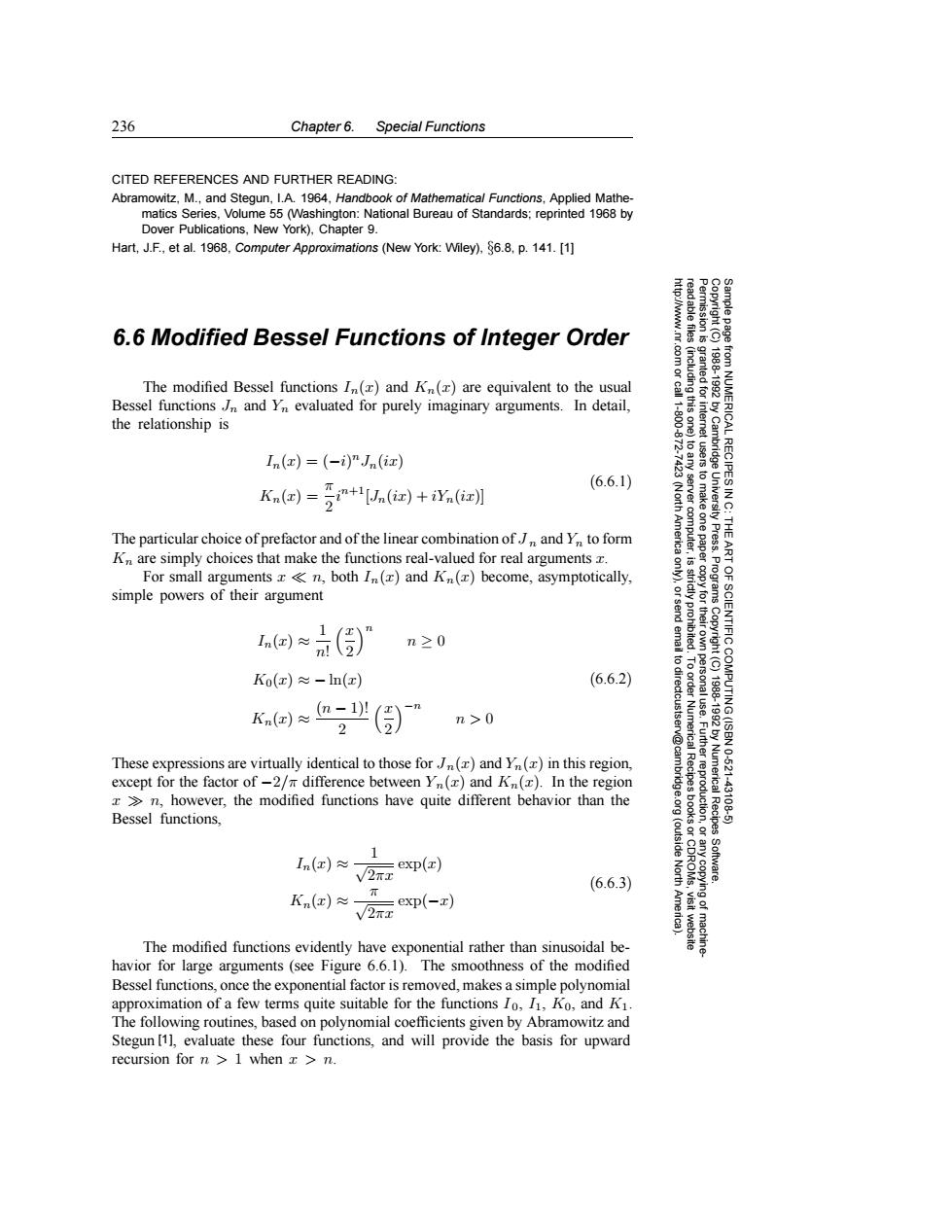正在加载图片...

236 Chapter 6.Special Functions CITED REFERENCES AND FURTHER READING: Abramowitz,M.,and Stegun,I.A.1964,Handbook of Mathematical Functions,Applied Mathe- matics Series,Volume 55(Washington:National Bureau of Standards;reprinted 1968 by Dover Publications,New York),Chapter 9. Hart,J.F.,et al.1968,Computer Approximations (New York:Wiley),86.8,p.141.[1] 6.6 Modified Bessel Functions of Integer Order The modified Bessel functions In(z)and Kn(x)are equivalent to the usual Bessel functionsIn and Yn evaluated for purely imaginary arguments.In detail, the relationship is In(x)=(-i)"In(ix) K国=+u(创)+.(m (6.6.1) 芝3、 9 The particular choice of prefactor and of the linear combination ofJn and Y to form K are simply choices that make the functions real-valued for real arguments z. For small arguments n,both In(z)and Kn(x)become,asymptotically, simple powers of their argument A三9 In()≈ ()” n>0 IENTIFIC 6 Ko(x)≈-n(x) (6.6.2) Kn(a)≈n- 2 2 n>0 (ISBN These expressions are virtually identical to those for Jn()and Yn(x)in this region, 10521 except for the factor of-2/m difference between Yn(z)and Kn(z).In the region Numerical xn,however,the modified functions have quite different behavior than the 431 Bessel functions, (outside Recipes In(d)≈√2 =exp(x) (6.6.3) North Kn(e)≈π =exp(-z) 2π The modified functions evidently have exponential rather than sinusoidal be- havior for large arguments(see Figure 6.6.1).The smoothness of the modified Bessel functions,once the exponential factor is removed,makes a simple polynomial approximation of a few terms quite suitable for the functions Io,I1,Ko,and K1 The following routines,based on polynomial coefficients given by Abramowitz and Stegun [1],evaluate these four functions,and will provide the basis for upward recursion for n 1 when n.236 Chapter 6. Special Functions Permission is granted for internet users to make one paper copy for their own personal use. Further reproduction, or any copyin Copyright (C) 1988-1992 by Cambridge University Press. Programs Copyright (C) 1988-1992 by Numerical Recipes Software. Sample page from NUMERICAL RECIPES IN C: THE ART OF SCIENTIFIC COMPUTING (ISBN 0-521-43108-5) g of machinereadable files (including this one) to any server computer, is strictly prohibited. To order Numerical Recipes books or CDROMs, visit website http://www.nr.com or call 1-800-872-7423 (North America only), or send email to directcustserv@cambridge.org (outside North America). CITED REFERENCES AND FURTHER READING: Abramowitz, M., and Stegun, I.A. 1964, Handbook of Mathematical Functions, Applied Mathematics Series, Volume 55 (Washington: National Bureau of Standards; reprinted 1968 by Dover Publications, New York), Chapter 9. Hart, J.F., et al. 1968, Computer Approximations (New York: Wiley), §6.8, p. 141. [1] 6.6 Modified Bessel Functions of Integer Order The modified Bessel functions In(x) and Kn(x) are equivalent to the usual Bessel functions Jn and Yn evaluated for purely imaginary arguments. In detail, the relationship is In(x)=(−i) nJn(ix) Kn(x) = π 2 i n+1[Jn(ix) + iYn(ix)] (6.6.1) The particular choice of prefactor and of the linear combination of J n and Yn to form Kn are simply choices that make the functions real-valued for real arguments x. For small arguments x n, both In(x) and Kn(x) become, asymptotically, simple powers of their argument In(x) ≈ 1 n! x 2 n n ≥ 0 K0(x) ≈ − ln(x) Kn(x) ≈ (n − 1)! 2 x 2 −n n > 0 (6.6.2) These expressions are virtually identical to those for Jn(x) and Yn(x) in this region, except for the factor of −2/π difference between Y n(x) and Kn(x). In the region x n, however, the modified functions have quite different behavior than the Bessel functions, In(x) ≈ 1 √ 2πx exp(x) Kn(x) ≈ π √2πx exp(−x) (6.6.3) The modified functions evidently have exponential rather than sinusoidal behavior for large arguments (see Figure 6.6.1). The smoothness of the modified Bessel functions, once the exponential factor is removed, makes a simple polynomial approximation of a few terms quite suitable for the functions I 0, I1, K0, and K1. The following routines, based on polynomial coefficients given by Abramowitz and Stegun [1], evaluate these four functions, and will provide the basis for upward recursion for n > 1 when x>n.�